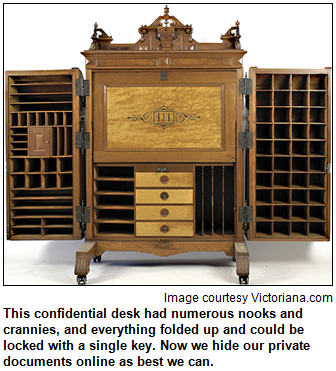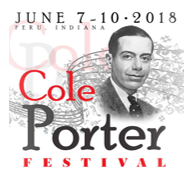Saturdays, noon to 1 p.m. ET on WICR 88.7 FM.
Or listen live from anywhere on WICR Online!
Our call-in number during the show: (317) 788-3314

June 9, 2018
How to furnish an historic home: Encore presentation
(This show was originally broadcast on January 10, 2015)
Maybe your home's interior has a Victorian-era theme. Or is your preference for an even earlier period, like the Colonial era? Perhaps a much later era, such as the 1950s or '70s, is your decorative dream.
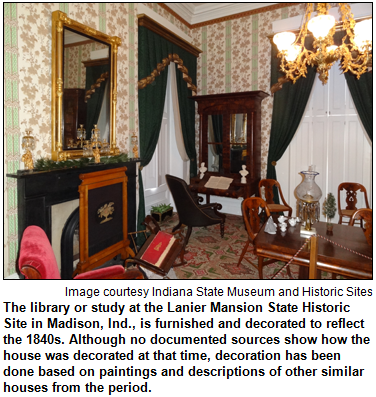 To offer advice about furnishing homes with period themes, Hoosier History Live is calling in three experts with track records of making period-appropriate decorating decisions about distinctive homes, including some of Indiana's historic sites. Our topics will include plenty of do's and don'ts. We also will explore the care, treatment and placement of period furniture.
To offer advice about furnishing homes with period themes, Hoosier History Live is calling in three experts with track records of making period-appropriate decorating decisions about distinctive homes, including some of Indiana's historic sites. Our topics will include plenty of do's and don'ts. We also will explore the care, treatment and placement of period furniture.
Nelson will be joined in studio by:
- David Buchanan of Indianapolis, curator of decorative objects and furniture for the Indiana State Museum and Historic Sites.
- Link Ludington of Madison, director of historic preservation for the state museum and historic sites. He also is an architectural historian.
- And Greg Ziesemer also of Madison, an antique furniture conservator and owner of Antique Furniture Restoration Inc. He also is a folk musician.
Along with advice for homeowners, our guests will share anecdotes related to their restoration, furnishing and conservation experiences.
Regarding antique furniture, they will talk about reproductions - along with, as our guest Link Ludington puts it, "reproductions that are now legitimate antiques." In addition, he plans to discuss whether investing in antiques is a good idea; tips about starting collections; fakes and forgeries; and "matching furnishings to the period and style of a house versus eclectic collections."
 Link, who says his career has been shaped by "a lifelong interest in the architecture, decorative arts and furniture of the 19th century," is the vice president of the Cornerstone Society Inc. It is the historic preservation advocacy organization in Madison.
Link, who says his career has been shaped by "a lifelong interest in the architecture, decorative arts and furniture of the 19th century," is the vice president of the Cornerstone Society Inc. It is the historic preservation advocacy organization in Madison.
Some other tidbits:
- David Buchanan lives in an Italianate home built in 1870 that is considered the closest private residence to Monument Circle.
- Among the conservation experiences Greg Ziesemer regards as his most cherished: helping conserve a corner cupboard made in Indiana by Thomas Lincoln, father of future president Abraham Lincoln. (During a Hoosier History Live show in February 2014, we explored Abe Lincoln's relationships with his parents and Thomas' outstanding skills as a furniture maker.)
- Greg Ziesemer also has been involved with historic furnishings at the Lanier Mansion in Madison (where our guest Link Ludington once was the curator); the Benton House in the Irvington neighborhood of Indianapolis and the IU Memorial Union in Bloomington.
 Often described as the "crown jewel" of the historic district in Madison, the Lanier Mansion was built in the 1840s by
Often described as the "crown jewel" of the historic district in Madison, the Lanier Mansion was built in the 1840s by  early Indiana architect Francis Costigan, who designed other buildings in Madison and Indianapolis. In the 1850s, Costigan designed a hotel in Indianapolis at a site on South Illinois Street that, ever since, has been the setting for a hotel.
early Indiana architect Francis Costigan, who designed other buildings in Madison and Indianapolis. In the 1850s, Costigan designed a hotel in Indianapolis at a site on South Illinois Street that, ever since, has been the setting for a hotel.
In Madison, the historic district includes more than 130 blocks. Homes are said to reflect every era of the Ohio River town's development between 1817 and 1939.
With its Corinthian columns on the south portico, Doric pilasters (ornamental columns) and other features, the Lanier Mansion in Madison is considered one of the best examples of Greek Revival architecture in the country.
Few of our listeners live in a house with that kind of rich history and spectacular features. But our guests plan to offer advice for a range of owners of houses with period-focused themes. Link, for example, will share his take on "buying what you like and can afford instead of what someone tells you to like."
History Mystery
|
A type of desk created during the 1870s in Indiana became famous across the country and is considered one of the most significant successes of the state's woodworking industry. The desks, which featured built-in pigeonholes with specialized storage for letters, were made by an Indianapolis furniture shop.
Often made of walnut, the desks were known for consolidating work and storage space by providing nooks and crannies.
The name of the desks was derived from the Hoosier businessman who established the furniture shop in Indianapolis. John D. Rockefeller, Ulysses S. Grant and other famous Americans used the desks, which often had folding doors that could be locked, protecting the contents.
Question: What was the name of the Indiana-made desk?
Because this is an encore presentation, we will not be accepting calls for the History Mystery.
Roadtrip: Carter House in Corydon
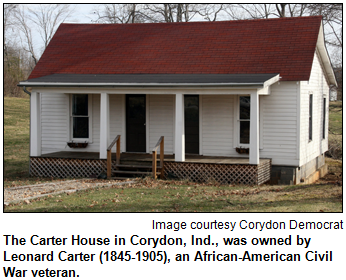 Guest Roadtripper and historic preservationist Maxine Brown of Corydon will tell us about the challenges in correctly decorating and furnishing what she calls "the modest home of an everyday African American living in the 1890s."
Guest Roadtripper and historic preservationist Maxine Brown of Corydon will tell us about the challenges in correctly decorating and furnishing what she calls "the modest home of an everyday African American living in the 1890s."
The Carter House in Corydon was owned by Leonard Carter (1845-1905), an African-American Civil War veteran born in Floyd's Knobs, Ind., who fought with the Civil War 28th U.S. Colored Troops, Company C, and was wounded at the Battle of Petersburg (also known as the Battle of the Crater, which serves as the opening scene in the movie Cold Mountain).
After the Civil War, Leonard Carter settled in Corydon and married Easter Perry in 1866. They had nine children, and he built a small bungalow for his family at 545 S. Floyd St. around 1891. The Carter House was saved from demolition and is being restored. It has been moved to Hill Street, close to the Leora Brown Colored School, another African American landmark in Corydon. The Carters and some of their children are buried in Cedar Hill Cemetery in Corydon near where the house stands now.
Prizes solicited for History Mystery contest
If your business or organization would like to contribute prizes for our History Mystery contest, we would love to have them! Ideally they fit in a standard mailing envelope, such as coupons or vouchers.
Your organization gets a mention on the air by Nelson, as well as a link to your website on our enewsletter and website! If interested, contact producer Molly Head at molly@hoosierhistorylive.org.
Nelson Price, host and historian
Molly Head, producer/project manager, (317) 927-9101
Michael Armbruster, associate producer
Cheryl Lamb, administrative manager
Richard Sullivan, senior tech consultant
Pam Fraizer, graphic designer
Garry Chilluffo, special events consultant
Please tell our sponsors that you appreciate their support!

 Acknowledgments to Monomedia, Visit Indy, WICR-FM, Fraizer Designs, Heritage Photo & Research Services, Henri Pensis, Chris Shoulders and many other individuals and organizations. We are an independently produced program and are self-supporting through organizational sponsorships and individual contributions. We do not receive any government funding. Visit our website to learn how you can support us financially. Also, see our Twitter feed and our Facebook page for regular updates. And thanks to the Indiana University Bicentennial for sponsoring the podcast of the "Faculty war of 1832: Early IU history" show. Any of our podcasts can be sponsored for a nominal fee.
Acknowledgments to Monomedia, Visit Indy, WICR-FM, Fraizer Designs, Heritage Photo & Research Services, Henri Pensis, Chris Shoulders and many other individuals and organizations. We are an independently produced program and are self-supporting through organizational sponsorships and individual contributions. We do not receive any government funding. Visit our website to learn how you can support us financially. Also, see our Twitter feed and our Facebook page for regular updates. And thanks to the Indiana University Bicentennial for sponsoring the podcast of the "Faculty war of 1832: Early IU history" show. Any of our podcasts can be sponsored for a nominal fee.
Thank you!
We'd like to thank the following recent, new and renewal contributors whose donations help make this show possible!
- Daniel Craig
- In memory of Elizabeth Meyer Strain Gunn by Roz Wolen
- Margaret Smith
- Stacia Gorge
- Robin Jarrett
June 16, 2018 - Upcoming
Superhero heritage in Indiana
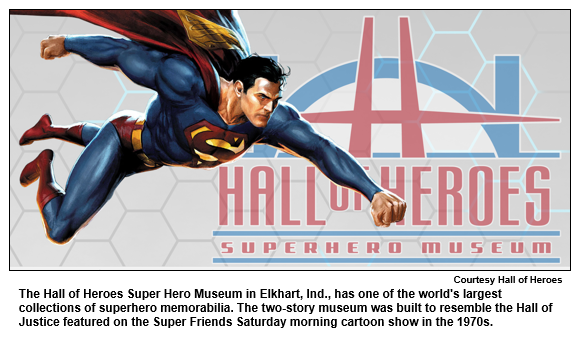
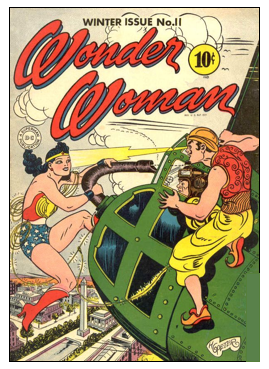
Even so, as we note the 80th anniversary of the introduction of Superman - his debut in a 1938 comic book is regarded as the launch of the superhero phenomenon - a stack of reasons nearly a tall as a skyscraper justify showcasing the Hoosier state's association with these champions of Truth, Justice, and the American Way.
In Elkhart, the Hall of Heroes Superhero Museum has one of the world's largest collections of superhero memorabilia. The two-story museum - built to resemble the Hall of Justice featured on the Super Friends Saturday morning cartoon show in the 1970s - has more than 60,000 comic books; they include comics from 1941 and '42 in which Captain America and Wonder Woman, respectively, made their first appearances. Other artifacts include a Batman costume worn by the late actor Adam West, who portrayed the Caped Crusader in a popular 1960s TV series; more recent memorabilia include a Shelby Cobra sports car from the movie Iron Man (2008).
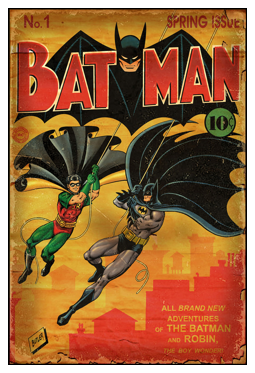
On June 16 - the day of our show - the Children's Museum also will open the interactive exhibit DC Super Heroes: Discover Your Superpowers, in which visitors are invited to join forces with Superman, Green Lantern, the Flash, Wonder Woman and other characters to solve problems and catch arch-villains.
For those who would dismiss superheroes as a trivial subject unworthy of examination by historians, consider the social history reflected in comic books and cartoons of various eras. The Hall of Heroes Superhero Museum's comic book collections include a rare, World War II edition of one that's been called the "racist Superman;" its cover features the crime fighter with the wholesome reputation urging readers to "slap the Japs." Comic books from the Cold War era of the 1960s depict the Hulk and Iron Man taking on evil-doers from the former Soviet Union.
For our exploration of Indiana's connections to superhero history, Nelson's guests will be:
- Allen Stewart, an Elkhart native who founded the Hall of Heroes Superhero Museum in 2007, which has been featured on programs on the Discovery Channel and the Travel Channel as well as in nationally distributed magazines. The museum's memorabilia - which includes 10,000 toys, accessories and props and 100 pieces of artwork and animated cells in addition to the trove of comic books - has grown so rapidly that Allen is raising funds to move to a new site in Elkhart that will triple the museum's size.
And Chris Carron, director of collections at the Children's Museum. The Batman collection it acquired in 2016 includes a Gotham City license plate and phonebook from the 1966-68 ABC-TV series that starred West. The collection also has an array of gadgets marketed to promote the character such as "bat-a-rangs" (boomerangs), utility belts and a bat bike.
In the temporary DC Superheroes exhibit, which will run through Nov. 25 2018, visitors to the Children's Museum are urged to develop teamwork; for example, families can join Wonder Woman as she attempts to rescue artifacts that the villainous Cheetah has stolen from a museum of ancient history.
Home & Away magazine has described the Elkhart museum as "part roadside curiosity, part super-fan tribute and part blast from the past." In 2012, Stan Lee - the man who created some of Marvel's most popular characters and a major celebrity among superhero enthusiasts - visited the Hall of Heroes and, as our guest Allen Stewart puts it, "got us on the national radar. We just kind of exploded after that."
While exploring heroes, our show also will highlight a $38.5 million outdoor/indoor experience at the Children's Museum that salutes real-life sports notables. The Riley Children's Health Sports Legends Experience opened earlier this year on 7.5 acres with an "avenue of greatness" that highlights the stories of Indiana sports stars including Larry Bird, Oscar Robertson and Tamika Catchings. There also are immersive experiences for a range of ages in hockey, soccer, tennis, car racing (in pedal cars), golf and other sports.
© 2018 Hoosier History Live. All rights reserved.
|

